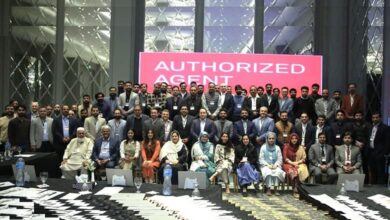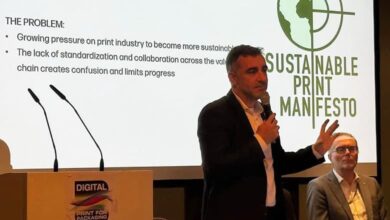“We Need to Make Printing More Appealing to Millennials”

Exclusive interview with Dr. Rajendrakumar Anayath, Vice Chancellor, Deenbandhu Chhotu Ram University of Science and Technology
The Indian printing industry has undergone a sea of change, post pandemic. The value of the print industry in India was estimated to be over INR 330 billion as of FY 2019. But the post pandemic scenario has seen an unprecedented crisis with shortage in raw materials coupled with sharp increase in prices, reduced market demands, price competitions, and a rush to capture a share of the shrunken pie. But many smart players in the industry began innovating their existing operations and equipping themselves with the right tools and technology to ensure their continuity amidst the crisis. Commercial printing was the worst affected and many small and medium printing houses were forced to close shop. One of the major transformations adopted by most printers was to have a digital makeover. The focus also shifted to packaging. With e-commerce becoming popular with their online shopping platforms, box and flexible packaging is showing promise in the near future catering to pharma, food and beverages, white goods, textiles, and FMCGs.
Col. Comdt. Prof. Dr. Rajendrakumar Anayath, Vice Chancellor, Deenbandhu Chhotu Ram University of Science and Technology, Sonepat, Haryana state, India, is a highly reputed researcher and academician in the field of print and media technology, and has several national and international awards to his credit. In the year 2020, he was also granted an Honorary rank by the Government of India and appointed as Colonel Commandant of the National Cadet Corps (NCC) for his unparallel contributions in academia, research, and administration.
In an exclusive interview, Prof. Anayath talks to ME Printer about the past, current and future trends of the printing industry; some of his researches about the industry, his stint with the Print Media Academy at Heidelberg, 3D printing, the impact of the COVID-19 pandemic, branding, and more.
We did meet a decade ago when you travelled to Dubai on behalf of Heidelberg media academy for a lecture. In your opinion how did the graphic arts industry evolve during the last decade?
To be honest, as a graphic arts academician and researcher, I am confused to answer this. I shall be truthful while answering this. I am convinced that many path breaking technological breakthroughs have occurred during the last decade. Many of the leading companies are going through a lot of turmoil, and this stress is having a lot of impact on our sector. Focus has been changed to quality, time, costs, digitalization, and automation. Predictions learned from DRUPA presentations are more to do with Industry 4.0, sustainability, demographical changes, security and brand protection, and data driven applications. The new developments on transparency for decisions, optimization of logistics and many benchmarks will also be available. Potential would be more in functional printing, industrial printing, finishing and decoration, package printing, active and intelligent packaging, ink jet applications, and textile printing. Dr. Markus Heering of VDMA also predicted that focus topics in the future would be based on Artificial Intelligence, connected customers, platform economy, and circular economy. While still there were a lot of developments, especially in maturing digital printing or in finding new ways of embellishments, there wasn’t much for a printer or a print entrepreneur who is the real lifeline of this industry. Lots of them are suffering, not all definitely. Even the global printing machine manufacturers are struggling for their survival and dominance. It is a worrying trend for me personally and definitely for anyone who loves printing.
Where is the print industry heading? What are future trends?
I answered this question in abstract while answering the first question itself. The industry is confronted with a variety of issues, and the idea of a realignment or reorganization of the sector cannot be postponed any farther. Environmental issues, digitization, social media effect, mobile influence, and e-commerce are areas of challenges and opportunities where the print sector must think and discover new prospects. We’re already late to grasp the significance of the elephant in the room.
There were lots of predictions about the printing industry that did not materialize. Like when the first digital printing press was unveiled in 1993 by Benny Landa, who said that conventional printing will cease to exist in less than a decade, something that clearly didn’t happen. So, in your opinion, what makes conventional printing processes such as offset printing so resilient?
I am one of the happy people; if it hadn’t turned out that way, many of my printer friends would have been in a lot of pain. I’m glad to see that their business is still thriving. We’ve all seen how offset wreaked havoc on the letterpress industry, causing many people to lose jobs and their businesses. To compete with traditional offset, digital must equal productivity, cost effectiveness, and flexibility, such as material compatibility. But offset technology is such a tried-and-true combination of engineering, technology, and science that digital won’t be able to compete with it overnight. Digital must be able to match, if not exceed, the power of offset machines. I am confident that this will happen. How fast digital presses will address the long run at comparable cost will decide how they emerge or replace offset. Now it is a coexistence, and the future is bright for digital due to many reasons; the mindset of the new generation of entrepreneurs will be a decisive factor.
Could you explain about some of the researches you carried out about printing industry and their results?
I focused more in colour science and produced two PhD’s and developed a new model for predictions of colour variation. Since 2006 I have worked very closely with a Croatian professor and scientist Vilko Ziljak on infrared-based invisible security designs. Later I had to move into an academic leadership role as a Vice Chancellor and could only do a limited amount of research. I still have a strong desire to do research for the printing industry’s benefit. Last year I made presentations for AIFMP and VDMA on Indian print industry. I attempt to help and mentor many postgraduates interested in printing and packaging research. The fact that the top technology and print businesses do not provide much assistance to researchers is astounding, and as a result, the research findings are restricted to academic purposes. I’d want to see industry leading companies assist young researchers who are interested in printing, packaging, and other related fields. I also wanted to see the industry build research laboratories to explore new processes, materials, and technologies suitable for each region. We shall also establish quality testing laboratories to benchmark our input and output materials, and, with the aid of scientific procedures, we shall become a more respectable industry.
You were a professor in Heidelberg’s Print Media Academy. How did you feel when you heard Heidelberg is selling the Print Media Academy building in Germany?
Shocked! And it was sad news for a humble individual who made his career and all achievements from this industry. And as someone who established this Print Media Academy in India from the ground up with a few bright Germans, I was in tears when I heard this terrible, devastating piece of information. As I previously stated, it is a concerning trend. It was a landmark not only for Heidelberg, but for the whole printing industry. It was like an Eiffel Tower or a Burj Khalifa of the print industry, iconic! Let us hope that the worst is over and that the larger corporations move to preserve not just their own financial books, but also the millions of people who make a living from this sector.

Many believe there is a shortage of skilled and trained expertise in the graphic arts industry. What can be done to encourage young people to choose a career in printing industry?
We need to make this sector more appealing to millennials. They have a misunderstanding about us. They have seen or heard of printing factories that are no longer the same. It’s now a sleek, appealing workplace with plenty of action and excitement. It doesn’t appear to be a garage or workshop, with paper flying everywhere and inks splattered everywhere. It’s as sterile and computerised as a hospital diagnostic setting. Many hospitals and companies do not have the technology that we do! There is lot of creativity; you deal with the best of brands, products or services there in your work. We must successfully communicate all these to the youngsters, and we shall bring them back. Who will infuse this enthusiasm, though, is the more pressing concern. Any industry, in my opinion, is worth the caliber of people that enters it. Our industry leaders shall introspect and act on this, to bring the mojo back, to convey what we do and who we need as our workforce – the future flag bearers.
Every day, we hear exciting news about 3D printing, a technology that’s breaking many barriers in different industries. Do you consider 3D printing a part of the graphic arts industry and in your opinion conventional or digital printers should consider moving into this segment of industry?
To begin with, 3D printing is manufacturing. It is the process of creating components, prototypes, and finished items by layer-by-layer deposition of diverse materials such as polymers, metals, and even ceramics. The deliverables are for a distinct set of requirements. However, there are many parallels between what we do as printers and what they do. Design, materials, production, inspection, and finishing are all engaged in the same sequence in both workflows. However, the final outcome is either end use parts or mechanical goods. Two of my close friends from printing are branching out into additive manufacturing, and I can see they’ve put in a lot of time and effort to become experts in 3D printing. However, one must realise that it is more of a mechanical engineers work. There is application of 3D printing for signages and communication purposes which can be leveraged by printers. I had an interface with the inventor of 3D printing, Chuck Hull, way back in 2011 at his Atlanta facility for a week. His vision about 3D printing is coming true much faster than even he would have thought.
What could be the long-term consequences of the COVID-19 pandemic for printing industry?
It has a negative influence since, as far as I can tell, the need for printing is dwindling worldwide. Many of our traditional business channels have shifted to digital communication. The question is, how can we resurrect it? How can we raise the demand for printing, and hence the size of the pie? Many industries have done the same thing when demand has decreased. The tale of the Michelin star is the finest illustration. We need to be motivated by such examples and work together to solve the problem. I’ve heard some encouraging news from Kerala, India, about a number of initiatives aimed at making print more lovable; it’s the need of the hour worldwide.
There is a huge gap between developed countries and the third world countries in terms of advancement in graphic arts industry. How can less developed countries fill this gap?
I believe that print consumption in wealthy nations is declining, thus third-world countries might open up a slew of new opportunities for the business.
Many printers still do not appreciate the importance of digital workflow and MIS systems. If a printer wants to embrace automation and advanced workflow systems, where does he have to start and how he can train his staff to be able to work with these systems?
First and foremost, these must be taught as part of the printing students’ curriculum. They will believe that this is normal and part of their regular work. The issue here is a mindset and a fear of being measured. We need to modify their mindset so that they are more conscientious and aware of manufacturing waste, productivity losses, and quality compromises. They will then adopt processes and management information systems (MIS). Entrepreneurs or leaders should embrace these first, then educate their teams on the advantages of these workflows and MIS data. It’s not only about saving money; it’s about predictability, repetition, and ultimately, quality, all of which contribute to a better customer experience. Whether you like it or not, the coming world will only accept that. Furthermore, no one can operate a firm without data, and data will have a massive influence on our businesses and profitability. MIS is the first step towards accepting this new paradigm.
What are the major turning points in the history of printing industry?
Bi Sheng’s clay type press to Gutenberg’s wine press to Alois Senefelder’s lithography to Ira Rubel’s offset press to digital to the Internet to AI is the short history of printing.
What is your take on branding during these strange times?
Branding is similar to the clothes we wear; regardless of how healthy, attractive, or handsome we are, we must wear them, and they have a greater influence than who we are in real life. Whether you like it or not, this is also true for products and services. To seem premium, you must nurture the brand, and to nurture a brand, you must communicate with the customer, and I still feel that print is the most reliable medium for communication. In today’s environment, the digital medium may be more convenient. However, there are several ways that print may help with branding and reputation. Nothing is exciting like a printed product or packaging to create the sensations of touch, feel, and trust. Other mediums simply fail to leave those lasting impressions. Everyone knows how the world celebrated the unpacking of iPhones. Packaging played a key role in creating that feel.
Last but not least, what would be the next disruptive technology in printing industry?
The next disruption will be caused by the combination of many technologies, rather than by a single technology alone. Print will incorporate Industry 4.0 technologies such as AR, VR, XR, AI, ML, robotics, big data and more, resulting in an immersive experience for customers (it’s already too late if this hasn’t happened yet). That, in my opinion, is the most significant upheaval print can offer in order to reclaim its mojo. I am eagerly waiting for those moments.
The industry must unitedly come forward to think of ways to improve the fortunes of print industry, and I am glad to be part of any such larger initiatives collectively and seriously taken by the leaders of print industry.






159 Comments